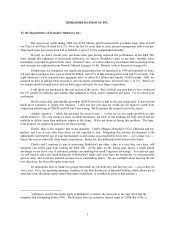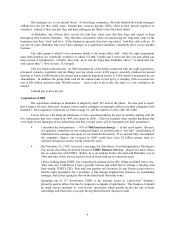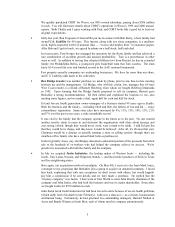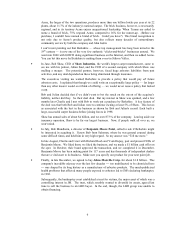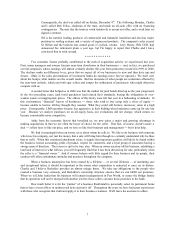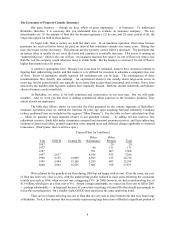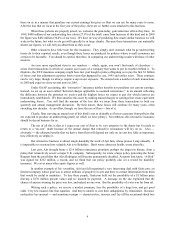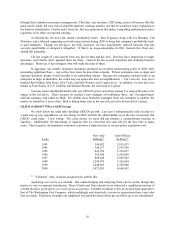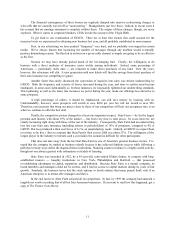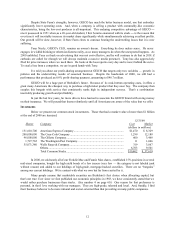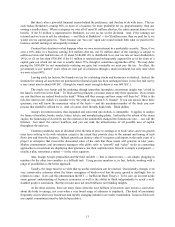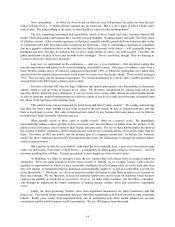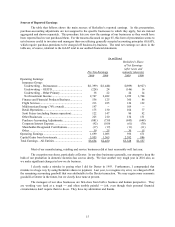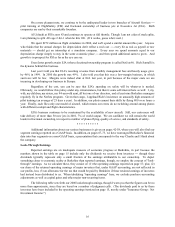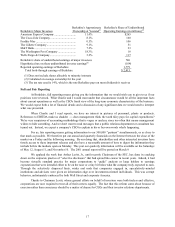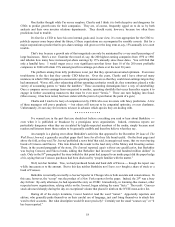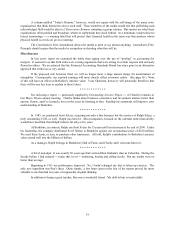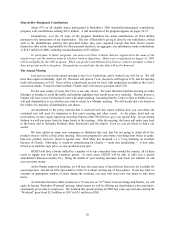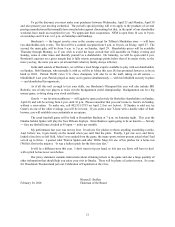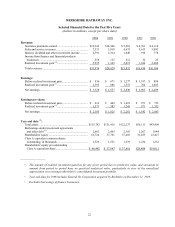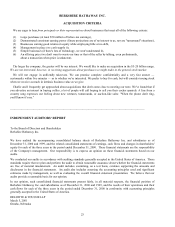Berkshire Hathaway 2000 Annual Report Download - page 14
Download and view the complete annual report
Please find page 14 of the 2000 Berkshire Hathaway annual report below. You can navigate through the pages in the report by either clicking on the pages listed below, or by using the keyword search tool below to find specific information within the annual report.13
But there’s also a powerful financial reason behind the preference, and that has to do with taxes. The tax
code makes Berkshire’s owning 80% or more of a business far more profitable for us, proportionately, than our
owning a smaller share. When a company we own all of earns $1 million after tax, the entire amount inures to our
benefit. If the $1 million is upstreamed to Berkshire, we owe no tax on the dividend. And, if the earnings are
retained and we were to sell the subsidiary not likely at Berkshire! for $1million more than we paid for it, we
would owe no capital gains tax. That’s because our “tax cost” upon sale would include both what we paid for the
business and all earnings it subsequently retained.
Contrast that situation to what happens when we own an investment in a marketable security. There, if we
own a 10% stake in a business earning $10 million after tax, our $1 million share of the earnings is subject to
additional state and federal taxes of (1) about $140,000 if it is distributed to us (our tax rate on most dividends is
14%); or (2) no less than $350,000 if the $1 million is retained and subsequently captured by us in the form of a
capital gain (on which our tax rate is usually about 35%, though it sometimes approaches 40%). We may defer
paying the $350,000 by not immediately realizing our gain, but eventually we must pay the tax. In effect, the
government is our “partner” twice when we own part of a business through a stock investment, but only once when
we own at least 80%.
Leaving aside tax factors, the formula we use for evaluating stocks and businesses is identical. Indeed, the
formula for valuing all assets that are purchased for financial gain has been unchanged since it was first laid out by
a very smart man in about 600 B.C. (though he wasn’t smart enough to know it was 600 B.C.).
The oracle was Aesop and his enduring, though somewhat incomplete, investment insight was “a bird in
the hand is worth two in the bush.” To flesh out this principle, you must answer only three questions. How certain
are you that there are indeed birds in the bush? When will they emerge and how many will there be? What is the
risk-free interest rate (which we consider to be the yield on long-term U.S. bonds)? If you can answer these three
questions, you will know the maximum value of the bush and the maximum number of the birds you now
possess that should be offered for it. And, of course, don’t literally think birds. Think dollars.
Aesop’s investment axiom, thus expanded and converted into d ollars, is immutable. It applies to outlays
for farms, oil royalties, bonds, stocks, lottery tickets, and manufacturing plants. And neither the advent of the steam
engine, the harnessing of electricity nor the creation of the automobile changed the formula one iota — nor will the
Internet. Just insert the correct numbers, and you can rank the attractiveness of all possible uses of capital
throughout the universe.
Common yardsticks such as dividend yield, the ratio of price to earnings or to book value, and even growth
rates have nothing to do with valuation except to the extent they provide clues to the amount and timing of cash
flows into and from the business. Indeed, growth can destroy value if it requires cash inputs in the early years of a
project or enterprise that exceed the discounted value of the cash that those assets will generate in later years.
Market commentators and investment managers who glibly refer to “growth” and “value” styles as contrasting
approaches to investment are displaying their ignorance, not their sophistication. Growth is simply a component
usually a plus, sometimes a minus in the value equation.
Alas, though Aesop’s proposition and the third variable that is, interest rates are simple, plugging in
numbers for the other two variables is a difficult task. Using precise numbers is, in fact, foolish; working with a
range of possibilities is the better approach.
Usually, the range must be so wide that no useful conclusion can be reached. Occasionally, though, even
very conservative estimates about the future emergence of birds reveal that the price quoted is startlingly low in
relation to value. (Let’s call this phenomenon the IBT Inefficient Bush Theory.) To be sure, an investor needs
some general understanding of business economics as well as the ability to think independently to reach a well-
founded positive conclusion. But the investor does not need brilliance nor blinding insights.
At the other extreme, there are many times when the most brilliant of investors can’t muster a conviction
about the birds to emerge, not even when a very broad range of estimates is employed. This kind of uncertainty
frequently occurs when new businesses and rapidly changing industries are under examination. In cases of this sort,
any capital commitment must be labeled speculative.


